| If you had a choice, a real choice, whether to brain calculate the clicks or holdover to shoot this elk at 400 yards, or to just look in your scope to where it says 400 yards and shoot it, what would you choose? This is a screen capture of the demonstration module on the Zeiss Sports Optics website. This example even includes a 10mph wind. Read on this is amazing technology in action. This is the Zeiss Conquest mounted on a CZ-550 Varmint in .308 Winchester that we shot at length with the Rapid-Z 600 reticle and correctly held over in distances from 200 to 500 yards at the range. This particular rifle is a .5 MOA gun out of the box, so the measurements were extremely precise. This is the Zeiss Victory FL Daviari with the Rapid-Z 1000 reticle on an Armalite AR-10 outfitted with a Teludyne Straightjacket system. It comes in about about 1 MOA and we acurately estimated ranges out to 1000 yards with Hornady Superformance 165gr. GMX in .308 Winchester. With the shorter barrel it clocks at about 1630 fps. and the Rapid-Z calculator easily adjusted for the difference from factory stats. Click on the image to view it bigger. You will see that the Rapid-Z 600 has a 200 yard zero built in. The “holdunder” for 100 yards is only roughly one to 1.5 inches so there is no 100 yard line. This is the Rapid-Z 1000 on the Zeiss Victory FL riflescope among others. The zero is 500 yards, but the calculator gives you a 100 yard zero point to set the scope up correctly. This is the first screen of the calculator after you log in with your email and zip code. Click for a bigger picture if you don’t feel like logging in now. The values you see here I got from the factory ammo option link for Hornady Superformance 165gr. GMX in .308 Winchester. When you choose a factory ammo option, first find the brand and line on the top, click Show Data, then find the actual stats from you ammo box and hit Update. Then go back to the Main Data Form. If you go into just the bullet data, it is a similar system. Once you find your manufacturer and bullet hit Update then go back to the Main Data Form. Then, once you are on the page, Click the blue Reticle Analysis Form link. On this page the default is Rapid-Z 600, so I updated the upper left corner with 10 power for the Conquest I was testing, then hit Submit Data, then hit the Optimize Power. It gives me a power setting of 7.68 out of 10 to make my lines on the Rapid-Z 600 reticle line up properly at their yardage marks. As you can see from Bar 3 through Bar 6, they are extremely close to the actual 100 yard dividers. To find interim yardage, just split the space by eyeball estimate and it works every time. As you can see from the upper right corner, my 100 yard hold is 1.68 inches over the 200 yard center crosshair. These are the numbers for the Rapid-Z 1000 with the same ammo in the same CZ-550 with a 24″ barrel. Out of possible 24x power, you set the scope for 22.67x. When I adjusted these numbers for the 2630 fps. velocity I measured with my Pact Chronograph on the AR-10, the calculator told me to re-adjust the power on the Victory FL to just over 20x power. Note that you “zero” the Rapid-Z 1000 for 500 yards, but the calculator gives you the data to actually zero the center crosshairs at 100 yards, 11.14 inches high in this case. So you aim the center crosshairds at the center of the 100 target, and it is properly zeroed for 100-500 yards when the hole hits 11.14 inches high. You can also use the 100 yard mark on the reticle itself to make it easier. The Victory FL series we tested has adjustable turrets as well as the reticle holdover, for shooters with different styles. And there is a parralax adjustment knob as well. The Conquest we tested has capped turrets with standard adjustments, and you use just the reticle to holdover and under for distance. I checked around and the internet retailers do have these scopes in both finishes, illuminated and not, in stock. I would try to buy them in person if you can though because side by side with the usual suspects in scopes is where you will understand what you are buying. Please visit the Zeiss Sport Optics website to learn about the actual features of these great riflescopes. Most of our time here has been devoted to understand the Rapid-Z reticle technology, and there is a lot of material on the interworkings of Zeiss scopes we did not cover in the interest of reading time. |
Zeiss Sport Optics
https://www.zeiss.com/sports
Try to quick calculate the “minutes of angle,” or MOA adjustment, for your riflescope on an big bull elk 435 yards away. Go ahead, try it, with the ammo you plan to use this hunting season. Some of you will say “no problemo” and easily be able to calculate the correct click adjustment or holdover quickly and quietly in your head.
The rest of us are a little too excited about the elk to have a clear enough head to do that. And many of us have little if any ability to calculate these kinds of things in our head on the fly even on our best day with no elk in the picture.
This has led to the advent of what I call “Zero Math Riflescopes.” With a Zero Math Riflescope, the lines in the scope reticle have already been pre-calculated at given distances for the ballistics of the load you are using. We’ve already covered this somewhat on the Nikon .223 series, but those scopes are really for only one load of one caliber. The lines in the reticle, or the clicks on the turret, match the distances if your velocity matches the standard value for that caliber, in this case 2340fps. for .223. But what if you have a shorter barrel than the test barrel on the ammo, or your handload doesn’t match the published numbers for factory ammo velocity?
The Zeiss Rapid-Z Reticle series, tested here on their Victory FL and Conquest riflescopes, calculates these numbers (click here to log in to the calculator) for any big game hunting caliber, and provides you with easy holdovers for distances from 100 to up to 1000 yards. The scope does this with no math whatsoever, and the online calculator explains how to make sure you scope is set correctly so that the 100 line hits at 100 yards, the 200 at 200, the 300 at 300, all the way up to 1000 at 1000 with the Rapid-Z 1000. Check out the pictures of the reticles here on the side. As you can see, they all have these what seem to be arbitrary lines, but they aren’t so arbitrary. The Rapid-Z calculator on the Zeiss Sport Optics website calculates the correct power setting on your riflescope to match these lines to actual distances downrange based on your ammo.
The calculator looks complicated when you first go in (you do have to provide your email and zip code to log into it), but once you hang around in there for a bit, the entire system becomes painfully simple, and you will find yourself slapping your forehead asking “why didn’t I invent that?” Start from the main data screen and you click either “Obtain Factory Ammo Data” or “Obtain Bullet Reloading Data.”
If you are using factory ammo, the former would probably be your choice if you have a 24″ barrel, which is the standard length for ballistic data on rifle calibers. If you don’t have a 24″ barrel, you should probably either buy a Pact Chronograph or ask the person who runs your local range if they could give you the number of someone in the club who might let you use one. Once you have the actual velocity of your ammo in your rifle, you can modify the factory velocity number in the Zeiss calculator to reflect your actual ballistics. Note however that you can self adjust the data as I’ll explain below, provided you have a range of at least 200 yards. A chronograph just makes it easier and saves you some ammo.
Going in through the “Obtain Bullet Reloading Data” is a similar process, but it doesn’t give you the factory quoted velocity, which you will plug in manually from your chronograph reading. Handloaders would use this option as well. If you know the BC of the bullet and your actual velocity, neither of these clicks are required. You would manually fill in these values and once you adjust your temperature, sight in distance and other factors, hit “Submit Data.”
Once your basic data is in, you click the link that says “Reticle Analysis Form.” This is the meat of the application. On that page, choose your Rapid-Z reticle. They come in 600, 800, and 1000 yard configurations, and a special Varmint version. Adjust your top power on the scope on your actual model. On the Zeiss Victory FL with the Rapid-Z 1000 test scope this is 24 power. With the Zeiss Conquest Rapid-Z 600 this is 10 power. Make sure your sight in distance is at the center crosshair distance on your reticle choice (look at the pictures), then click “Optimize Power.”
In blue text below that button it will now say “Optimum Power” and a number somewhere in the zoom range of the scope. This is the setting you should zoom your scope to in order for the holdover lines to work correctly. Burn this number into your brain and carry your rifle with your scope set to that power, because when the elk shows up, you may not remember to dial the scope in correctly. It is, fortunately, the only thing you have to remember with the Rapid-Z technology. The pre-calculations handle the rest.
After trying a few different ammunition choices (not all ammo choices hit the numbers correctly so check it), I settled on the Hornady Superformance 165gr. GMX in .308 Winchester. It produces 2750 fps. out of a 24″ barrel, and the ballistic coefficient (BC) of the bullet is .444. This calculates in the Rapid-Z 600 to a scope power of 7.68 (out of 10 in the Conquest). So I set my scope to about seven and three quarters power .
The Rapid-Z 600 is set up for a 200 yard zero. In order to have room to use pure holdover up to 600 yards, the 100 yard line is actually above the center of the crosshairs, and because it is only about an inch to an inch and a half higher for most hunting calibers, there is no “holdunder” line. You can estimate it on the target. The center of the crosshairs is 200, and the lines under it go to 600 for holdovers. If you look in the actual graphic here of the calculator, the actual distance calculations for the lines in the reticle aren’t perfectly these values, 302 for 300, 399 for 400, but they are pretty darn close, close enough to take home your elk.
This particular ammo choice works really well in the calculator, but the application is so smart that when I changed the actual velocity to 2630 to reflect the shorter barrel of the AR-10 you see in the pictures here, the calculator changed my optimum power to 6.91 and gave me the exact same distance values to match the lines in the reticle. Wrapping your brain around this can be difficult and it was for me at first, but what Zeiss has done is take what is actually a weakness of 2nd focal plane riflescopes and turned it into a tool to make your life easier and give your brain a free pass for math class.
In a second focal plane riflescope, the crosshairs always stay the same size and you suck in or push out the target picture. This is how “standard” riflescopes work in America. The problem with this is that when it comes to using your reticle lines for ranging and holdover, the proportion of target mass in relation to the lines change while you zoom. All standard second focal plane scopes will have a power setting on which the Mil-Dot (Mrad) or MOA lines will be accurate (if your scope company even bothers to put lines on the crosshairs), and if the scope isn’t on that power, your calculations will be off. Zeiss took this weakness and said “hey, we can use this to adjust for different ballistics in ammo,” and the Rapid-Z reticle system was born.
In the Zeiss Victory FL, which goes up to 24x in power, the optimum setting was 22.67 for the Hornady Superformance 165gr. GMX , and when I adjusted the velocity down to 2630, the power came down to 20.29. Brilliant! Brilliant! Brilliant! There are no other words for this Rapid-Z system from Zeiss.
This is another interesting feature of the online calculator. For the Rapid-Z 1000, your “sight in” is 500 yards. You may say “ouch I can’t do that at my 100 yard range” but the calculator factors that in. If you look on the upper right, below the sight in distance on the Reticle Analysis form, you will see an “Impact @ 100yds.” setting. In the picture of the screen I have here, you’ll see 11.14 inches. That means that if I zero my center crosshairs (the 500 yard setting on the Rapid-Z 1000) at 11.14 inches high at 100 yards, I will be dead on from 100-1000 using the holdover and holdunder on the reticle.
All of this may seem esoteric and nerdy at first, but when you go to the range (if you have one over 100 yards) and actually test it, it works. And you aren’t a slave to the numbers if you can’t use a chronograph to test your velocity. You can test on targets and adjust the power of the scope until it is correct from 100-200 yards. Once you have the scopes power setting correct to be able to utilize just the reticle from 100-200 yards just using holdovers, the entire range of the Rapid-Z reticle will match the numbers in the calculator.
In the high quality optics world Zeiss is one of very few names that nobody will ever question. Their optics are impossibly clear, with perfect edge to edge definition, perfect repeatability, and now the most advanced reticle system I have seen to date. The Victory FL series, with a street price on our test scope of just under $3,000, utilizes glass with fluoride ions in it, as well as advanced internal baffling and lens coatings to make your sight picture as clear and defined as if you were standing right in front of your target looking it directly in the face. Side by side you may be able to find scopes that are as clear and defined as a Zeiss, but especially under field conditions you will be hard pressed to find a scope that is noticeably better.
What I find very nice about the way Zeiss approaches their relationship with their customers is that the Conquest line, street price under $800 for our test scope, includes the same great reticle technology as the big money scopes. The Conquest scopes don’t have the advanced light passing technology of the Victory line, but they are still riflescopes made by Zeiss. You really have to go to a gunshop or big box retailer who has these scopes in stock and look through one. Then look through a scope from the usual suspects. You will find there is little if any comparison in that price range, and that if you compare the Zeiss side by side with a “regular old crosshairs” $400 riflescope, the bright, crystal clear sight picture and mind blowing reticle technology make the extra money well worth the lifetime investment in an extraordinary riflescope.
If after reading about the Rapid-Z you find yourself shaking your head that you don’t understand it, go log into the Zeiss Sport Optics website and walk through the instructions again while actually trying it with the screenshot numbers here in the examples. It doesn’t cost anything, and when the lights finally go on you will indeed slap yourself on the forehead as I did. Zeiss really has something here, and once you understand it I don’t think you will want to settle for less.
Zeiss Sport Optics
https://www.zeiss.com/sports




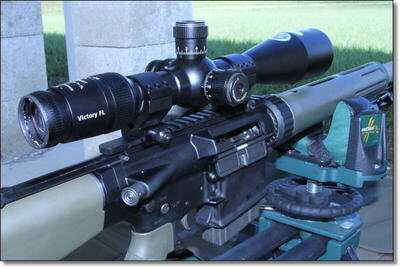
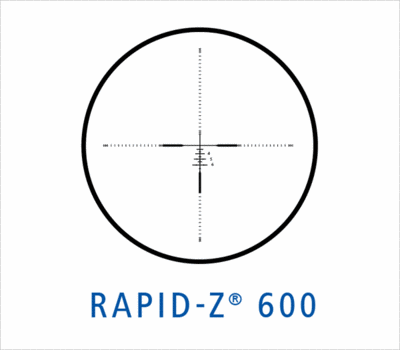
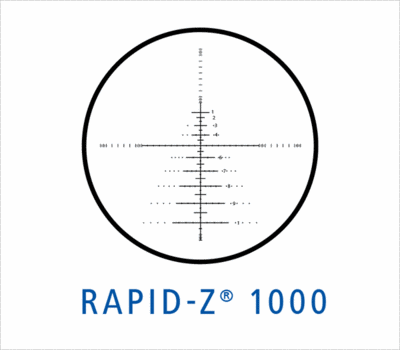
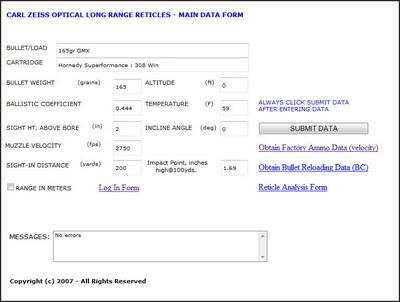

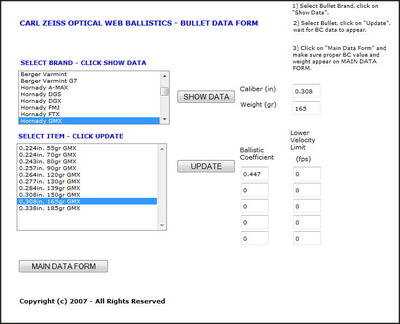
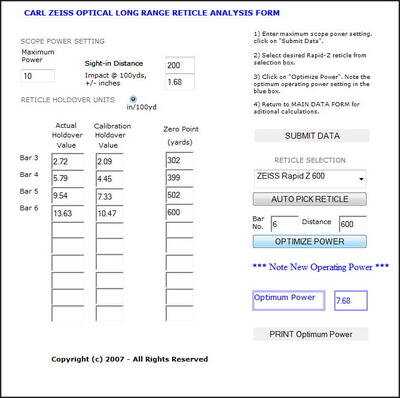
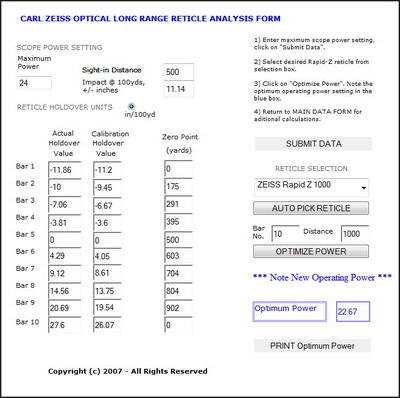

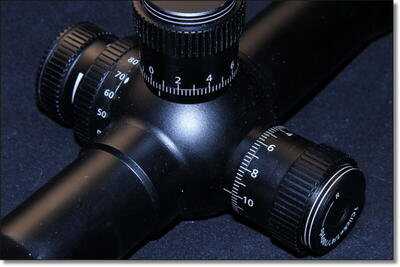



I just received my Conquest 3-15 x42 New Rapid Z 600 scope and I am very disappointed in its quality.
Once I started looking at the detail I noticed that the Magnification Ring marker does not line up with the actual numbers. It is 1/16 of an inch past the 3x and 1/16 of an inch past the 15x.. Zeiss America says it is correct for all other magnifications, but I wonder. Not what I expect for a $1100 scope.
A second and more important FLAW I noticed is that the reticle seems to be etched incorrectly for the 350 and 450 yards. It would appear that the 350 mark is closer to the 4 than the 3, indicating that there is more of a drop in the bullet between 300 and 350 than between 350 and 400. The same appears to be true for the 450 mark. Now I know as do most of you that the bullet drops more between 350 and 400 than between 300 and 350. Also more between 450 and 500 than 400 and 450.
Zeiss America says they have placed those marks there to allow for the average of all the calibers tested for this range of scope as well as their computer generated results for those calibers. I was under the impression that their Ballistic Calculator determined the Magnification Ring setting for each caliber taking into account some of the field conditions. It would appear to me that this is just a cover up story and that in fact the etching is incorrect at the 350 and 450 mark.
The distance between the etching for the 3, 4, 5 and 6 all seem to be a little larger which is what I would expect. The 550 mark also appears to be correct. So why just the 350 and 450. I believe It is a FLAWED reticle and I think Zeiss should recall all their scopes and replace the flawed reticle with a corrected one. I have not tested this scope in the field.
Maybe someone on the list can have a look at their Rapid Z 600 and post their comments.
I own a Conquest 6.5-20×50 AO scope, which I have used on bolt-action and semi-auto .308s alike. If you set up your scope and use the online Zeiss ballistic computer as directed, this system works very well. Recently, I had occasion to use it at maximum range – 1000 yards – and was able to get a high percentage of hits on a steel target 16″ across. This system is easy to use, and Zeiss glass is second-to-none. About the only drawback is that Zeiss hasn’t yet devised a stand-alone ballistic program – you will need internet access to account accurately for weather and atmospheric conditions in real-time. Since changes in temperature, humidity and other variables can alter the optimum magnification setting for the system, this is no small matter. I’d like to see a Rapid-Z mobile app for Androids from Zeiss.
This is an excellent system; I am thinking of getting a second Zeiss scope in fact, but in my opinion, the company erred a bit in making the lower-powered Rapid-Z reticles – the 600 and 800-yard variants – for cartridges that are longer-ranged than the .308 for which the RZ-1000 is designed. One-thousand yards is stretching the envelope for effective (supersonic) performance of the .308, but a 300 Win. Mag is still going strong at that range. Yet, 300 Win Mag users are directed toward the shorter-range reticles… which makes no sense.
Finally, the Zeiss ballistic computer uses the G1 ballistic coefficient, and not the more-accurate G7 number.
All in all, however, a very user-friendly system which is quite accurate.
Does Mr Evans still have his scope? Which one is it? Would he be interested in selling it?
Hi there,
For me, zeiss rifle scopes are the best. Thank you very much for sharing such great information about this sighting media.
– Felix
It’s a good idea, however I still feel more comfortable doing the math myself. I’m one of those techno-phobes who thinks that we will eventually lose skills by overusing technology.
The Zeiss site is horrible. I entered all my data, hit “submit data” and nothing happened. I’ll stick with the Nikon Spot On ballistics calculator site. At least it works.
I have the 3-9X40 on my rifle and plugged the numbers into the calculator for the desired power for my handload. With them this last weekend a trophy antelope’s life was ended from 500 yards with a shot through the heart. This scope works.
I have recently purchased a 338-378 Kubla Kahn Jarrett. I have a 8X 42 Night Force on a 30-338, of which I am fairly satisfied.
On the 6X20 do you make a reticle for the different weight bullets and speeds if I sent them to you? And what is the cost?
Kyle Walker
I am a big believer in this style of reticle. After having setup my 300 WSM with a Swarovski 4-12x50mm with the TDS reticle, I began to see the utility in a simple nearly foolproof method for compensating holdover at various ranges. Albeit, VERY quickly. You often don’t have time to mess with spinning dials and looking at cheat sheets. The experience with the TDS (now called the BRH and BRX) made me turn to the Rapid-Z reticle when setting up two new rifles for friends. One chose a 4.5-14x50mm Conquest with the Z-800 reticle and the other chose a 3-9x40mm with the Z-600, one sitting on a Kimber Montana in 300 WSM and a Remington XCR II in 300 WSM, respectively. We were able to successfully make hits inside a 6″ vital zone CONSISTENTLY out to 600 yards (the maximum distance at our range) using the correct holdover as indicated by the reticle. I was amazed. After just a careful sight-in at 200 yards, I was able to witness two relatively inexperienced riflemen make consistent vital zone hits shot after shot. Technology is no substitute for practice, but it definitely brought these two guys up to speed VERY quickly. Way to go Zeiss! (…and Swarovski!).
-MDL
This is an interesting concept. It seems like an adjustable BDC?
Every hunting rifle I own wears a Zeiss Conquest scope, but I bought them before this new reticle was available. I don’t hunt at the distances to actually need or utilize one, but I have to simply affirm what the author says about their line of scopes. They wrote that Zeiss Conquests cost $800 or less, but my normal deer stand rifle sports their 3-12×56 model, and it costs $1000 no matter who you buy it from. Nothing in their price point compares with Zeiss. Nothing. They’ve made me sell my Leupolds, etc. Great article!